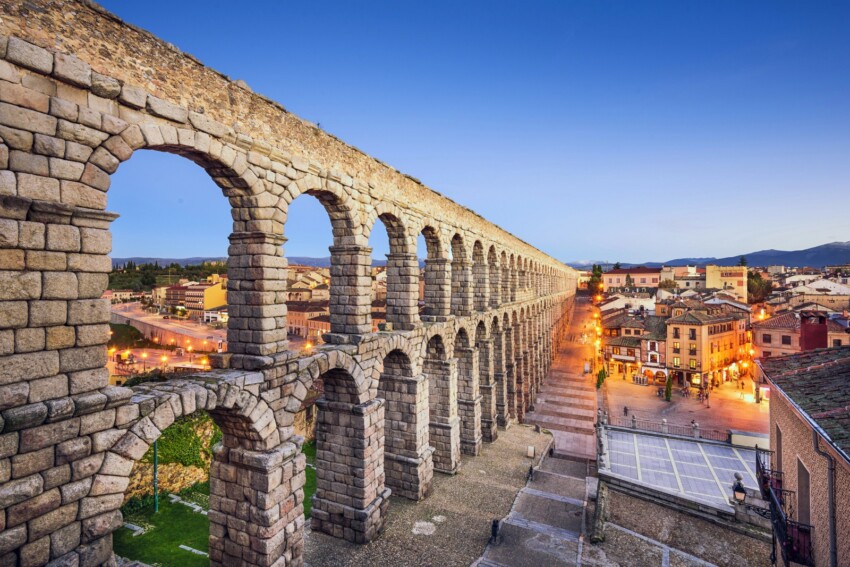

One of the oldest cities in Spain, Segovia is visited daily by tourists from Madrid and by pilgrims and hikers on the Camino de Santiago.
The truth is that this extraordinary city deserves a holiday of its own. Set in a natural environment of exceptional beauty, on a raised land between the courses of the Eresma and Clamores rivers with the Sierra de Guadarrama in the background, Segovia is rich in historical monuments that will leave you speechless.
The star of Segovian tourism is the impressive Roman Aqueduct, an engineering masterpiece of antiquity that survives in the centre of what is now a bustling modern city. Also not to be missed are the Alcazar and the Cathedral, two stunningly beautiful buildings.
A trip to Segovia is also an opportunity to sample the typical gastronomic specialities of the Castile and León region, such as cochinillo (roast suckling pig) and Segovian ponche (marzipan-covered cake), or for relaxing walks in the countryside.
The beating heart of Segovia’s historic centre is Plaza Mayor1, dominated by the imposing Cathedral and lined with historic buildings, cafés and arcades and made easily recognisable by a gazebo in the centre.
Also take a look at the smaller but pretty Plaza San Martín2, overlooked by the church of the same name and the 14th-century Lozoya Tower, now used for contemporary art exhibitions.
Apart from the aqueduct, there are many interesting attractions in the city of Segovia.
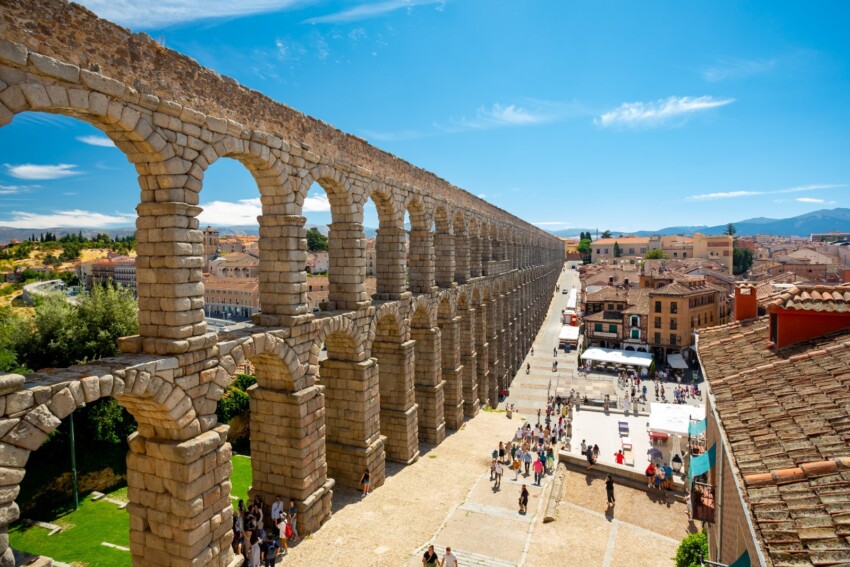
The symbol of Segovia is its magnificent Roman aqueduct, an architectural marvel dating back to the 1st century B.C. that can astound even the most astute contemporary tourists.
It is impossible not to wonder how the Romans could have achieved such a prodigy in such ancient times once you stand in front of this monumental construction: astonishing are its gigantic dimensions, the perfect cut of the stones, the absence of cohesion blocks. Impressive by day, the aqueduct of Segovia becomes particularly impressive at sunset.
The best preserved section of the aqueduct is the one at Plaza del Azoguejo, which is also the highest point; from there the aqueduct continues in good condition for a long stretch, but these are reconstructed parts, as you can easily see from the stones and the style of the arches.
For a splendid view of the aqueduct, climb the Postigo stairs: this is the best spot to admire the aqueduct in all its magnificence.
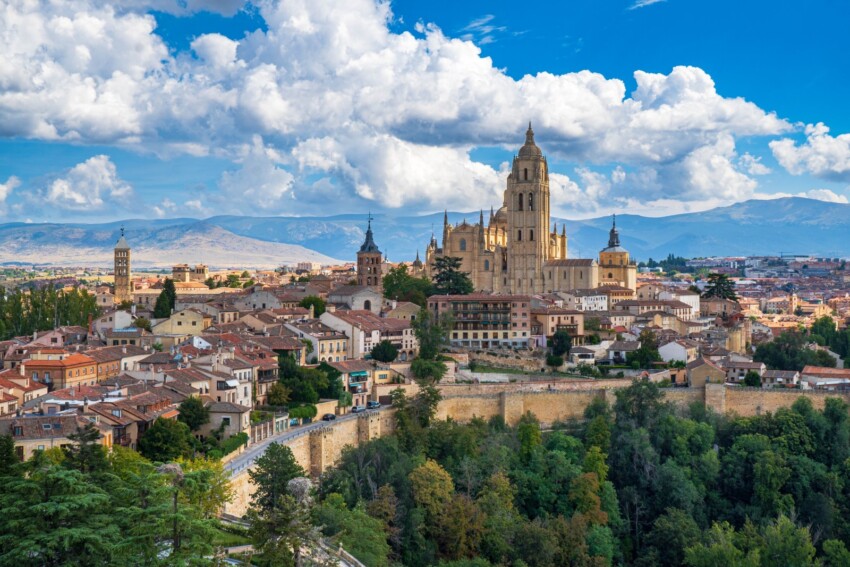
The construction of Segovia Cathedral, a magnificent example of Gothic architecture, began in the 16th century and took a good 200 years, but the result is of such beauty that perhaps it was worth the wait!
Its towers and pinnacles soar into the blue sky of Segovia creating a magnificent contrast; at sunset the stones turn a striking honey hue, making the view of the cathedral as a whole a sight not to be missed.
The spacious and austere interior has no less than 20 chapels: don’t miss the Capilla del Cristo del Consuelo, Capilla de la Piedad, Capilla del Cristo Yacente, and the Capilla del Santísimo Sacramento.
With the guided tour of the cathedral you will also have access to the tower, from which you can enjoy a panoramic view of the city. The adjoining museum, included in the price of the visit, exhibits a collection of sacred art objects.
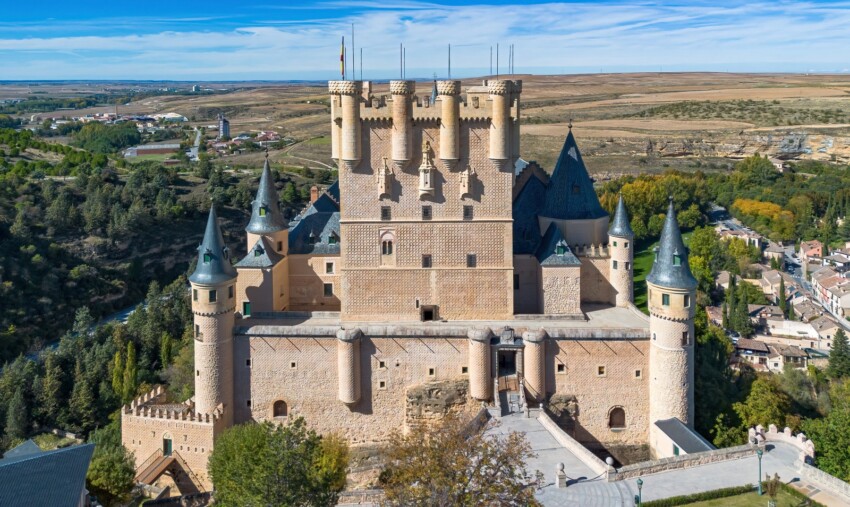
Originally built as a fortress, the Alcázar of Segovia is today more like a romantic fairytale castle. Surrounded by a beautiful natural landscape, perched on a hill at the confluence of the Eresma and Clamores rivers, it owes much of its charm to its towers and turrets with their characteristic tip, somewhat reminiscent of a witch’s hat.
Of ancient origin, it was modified several times over the centuries; what we see today is the result of a total reconstruction, made necessary by the heavy damage suffered by the building in 1862.
The two most beautiful rooms are the Sala de las Piñas, with an impressive gilded ceiling decorated with 392 artificial stalactites in a curious pineapple shape (hence the name of the room), and the Sala de los Reyes, where you can admire the 52 statues of kings who fought during the Reconquista.
The highlight of a visit to the castle, however, is the magnificent view of Segovia and its surroundings from the top of the Tower of John II.
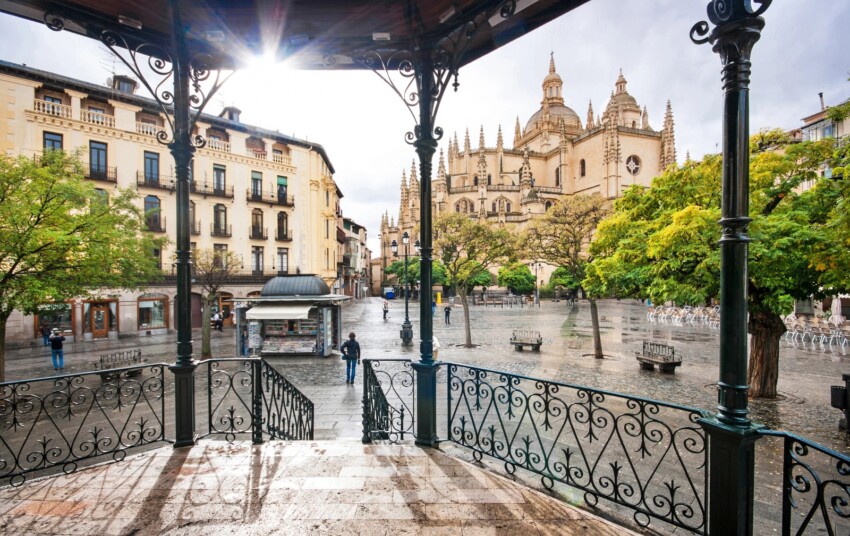
Segovia’s Plaza Mayor is the beating heart of the city. Surrounded by arcaded buildings, the square is dominated by the church of San Miguel, where Isabella the Catholic was proclaimed Queen of Castile. The arcades are home to numerous bars and restaurants where you can enjoy traditional Segovian cuisine.
The square is particularly lively during patron saint’s days and weekly markets. In summer, the café terraces are filled with locals and tourists enjoying the lively atmosphere of the city centre.
The Real Casa de Moneda in Segovia was the first mint in Spain and is also one of the oldest in the world. Its establishment dates back to the 15th century, when the Catholic Monarchs, Ferdinand II of Aragon and Isabella I of Castile, decided to create a mint to mint coins in the Kingdom of Castile.
The Segovia mint played a crucial role in the production of coins for the Kingdom of Castile and, later, for Spain. It minted coins of various denominations, including the famous ‘pieces of eight’ that were widely used in the Spanish colonies in America. The mint continued its minting activity until the 19th century.
The original structure of the Real Casa de Moneda is a building of great historical and architectural importance, and was designed by architect Juan de Herrera, known for his work at the Escorial Monastery.
Today, the Real Casa de Moneda in Segovia has become a cultural and tourist centre. Visitors can explore the museum inside the building, which offers an overview of the history of the mint and the coin minting process. The building has been restored and preserves many of the original tools and machinery used in the minting of coins in past centuries.
A name inextricably linked to Segovia is that of Antonio Machado, a Spanish poet and exponent of the current known as Generacion del 98 who was a fervent opponent of European totalitarian regimes.
The museum Casa de Antonio Machado, where the poet lived from 1919 to 1932, exhibits original furniture and objects that belonged to the writer, as well as a bust of him, portraits and photographs.
If you are interested in getting to know a local artist, visit Museo de Arte Contemporáneo Esteban Vicente9, which exhibits 153 works including abstract paintings, lithographs and sculptures by Esteban Vicente, a Segovian painter who followed the current of abstract expressionism.
Other art is on display at Museo Gastronómico10, a small private museum that will introduce you to the gastronomic excellence of Segovia. For a small extra charge you will also have a tasting of typical products; if you are short on time, you can pop into the museum shop to buy tasty souvenirs.
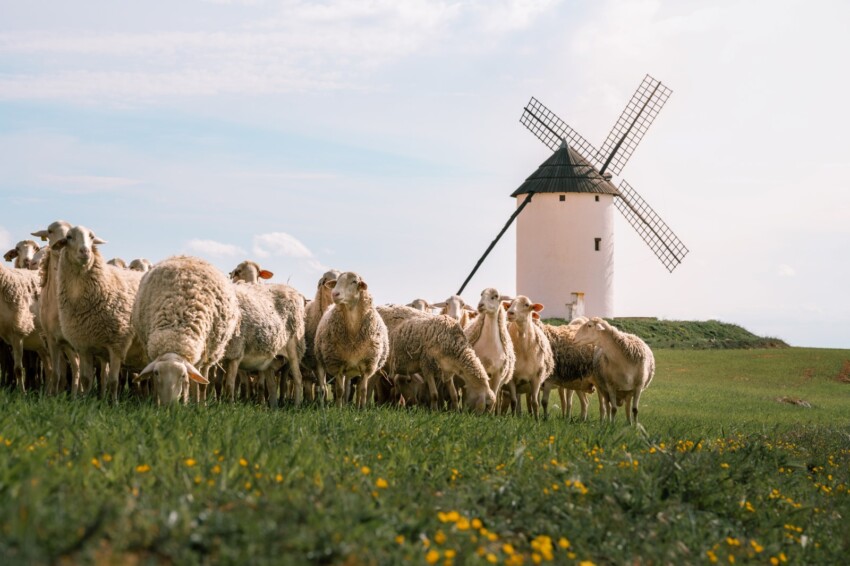
A less famous but extremely fascinating attraction is the path of the mills, a route along the rivers of Segovia that takes you to a little-known but breathtakingly beautiful part of the city.
It is a walk through lush green vegetation, with the sound of the river flowing in the background, that takes you to discover the importance that these waterways had for the industrial development of the city. Along the route you will find mills and old factories, with information panels explaining their history.
The signposted route is about 3 km long and can be covered in an hour; it does not present any particular difficulties and is therefore suitable for everyone, but it is advisable to wear walking shoes due to the conformity of the terrain.
The starting point is the aqueduct at the Carrettera de Bocequillas bridge, now Via Roma; the finishing point is the Real Casa de Moneda.
In the following map you can see the location of the main places of interest mentioned in this article.
Segovia is part of the classic day trip from Madrid, so several tours and guided visits are organised each day, including other places around Madrid such as Toledo and Avila. This is certainly the most convenient way to visit Segovia.
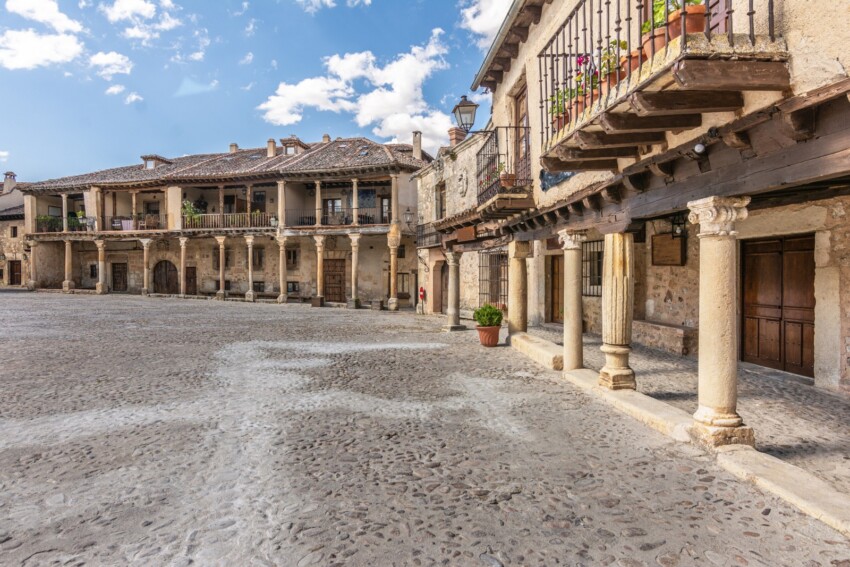
Segovia’s location, between the Sierra de Guadarrama and the Castilian plain, offers numerous possibilities for interesting excursions.
Just 11 km from Segovia, the Royal Palace of La Granja is one of the most beautiful Baroque complexes in Spain. Built by Philip V on the model of Versailles, the palace is surrounded by spectacular gardens with monumental fountains. The days when the fountains are in operation are particularly impressive.
The medieval village of Pedraza, 37 km from Segovia, is one of the best preserved in Spain. Its walls, castle and arcaded plaza mayor create an architectural ensemble of extraordinary beauty. In July, candle concerts transform the village into a magical setting.
The Sierra de Guadarrama National Park offers numerous possibilities for excursions and outdoor activities. The area of Navacerrada, famous for winter sports, is easily accessible from Segovia and also offers beautiful excursions in summer.
Due to its proximity to Madrid, many people reach Segovia on a day trip directly from the Spanish capital. However, if you intend to have a touring holiday or want to spend the evening there, it might be convenient to book a hotel in Segovia.
The historic centre offers the most atmospheric accommodation, with boutique hotels in old palaces and guesthouses that allow you to experience the authentic atmosphere of the medieval city. The area around the Plaza Mayor is particularly convenient for access to the main monuments and nightlife.
The neighbourhood of San Millán, just outside the historical centre, is a quiet area with good accommodation at lower prices. The area is well connected and offers spectacular views of the Aqueducto. The Aqueducto area offers hotels of different categories with views of the Roman monument. The location is strategic for those arriving by public transport, being close to the bus station.
If you have rented a car, you can reach Segovia in about an hour and a quarter by taking the A6 and continuing along the AP6 and AP61.
Segovia is well connected to Madrid by public transport: there are direct buses that leave frequently and high-speed trains (AVE) that will get you there in just 30 minutes. Keep in mind, however, that the AVEs are not cheap trains and that the station is located outside the centre and can be reached by bus in about 15 minutes.
Those who enjoy sightseeing in the company of an experienced guide can join one of the many day tours in Segovia departing from Madrid, perhaps in combination with other fascinating locations such as Avila.
What's the weather at Segovia? Below are the temperatures and the weather forecast at Segovia for the next few days.
Segovia is located in the province of the same name, within the Castile-Leon region. It is located less than an hour from Avila in a north-westerly direction and an hour and a quarter from Madrid in a north-easterly direction.